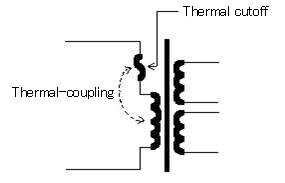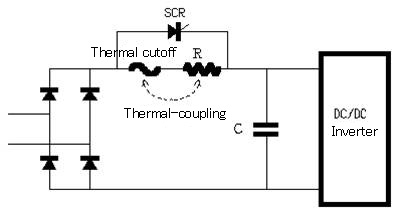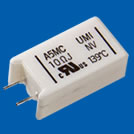Utilization Technology
As we mentioned, it is clearly possible that heating device is thermally coupled with thermal cutoff and thermal cutoff opens the circuit at the planned temperature at which the device should be protected.
Fig. 4 is the usage example of coil products like motors or transformers. The thermal cutoff is directly put in contact with surface of coil via insulation film, so it can detect the heat which is generated by short of transformer’s secondary coil or lock of motors directly.
Usually, the circuit architecture whose main circuit is shut downed by function of thermal cutoff should be advisable.
Fig. 5 is the usage example of inrush current limiting circuit in switching power supply.
The resistor is bypassed by thyristor at normal operation. But when the thyristor becomes non-conductive due to circuit abnormality, the resistor will generate abnormal heat.
This example is the solution indicating that thermal cutoff detects the abnormal heat and open the circuit. The configuration is the resistor coupled with thermal cutoff, or the cement resistor which has a built-in thermal cutoff. (Pic. 2)
Fig. 4 Example of overheat protection of transformer

Fig. 5 Example of overheat protection of resistor in inrush current limiting circuit

Picture 2
Thermal cutoff/ resistor assemblies A5MC series

Caution to be observed when designing for use of thermal cutoffs
When designing, make it sure to secure as much longer lead wires as possible, and put lead wires and body to the nearest place where heat generates in order to ensure the thermosensitive function. When using thermal cutoffs in equipment with coil winding such as transformers and motors, install the thermal cutoffs in places with good heat conductance, which will allow them to most directly detect the heat of the coil windings. Design equipment so that the bodies and both lead wires of thermal cutoffs are evenly heated.
- When designing end products, be sure that thermal cutoffs are not installed in location where they would be subject to severe or continuous vibration.
- Design end products so that, after a thermal cutoff functions due to abnormal heating of the equipment, the thermal cutoff cannot exceed the specific maximum temperature limit due to the overshoots.
- Install thermal cutoffs so that their function can be triggered only by abnormal high temperatures.
- Although thermal cutoffs are highly reliable, there are limits to the abnormal status with which a single thermal cutoff can cope. Furthermore, if a thermal cutoff is damaged for some reason, it is possible that it will not break a circuit under abnormal conditions. If there is a possibility that personal or property damage would arise when a circuit does not break during abnormal equipment operation (i.e. when there is a high required safety level), it is effective to add one or more thermal cutoffs with different temperature ratings.
